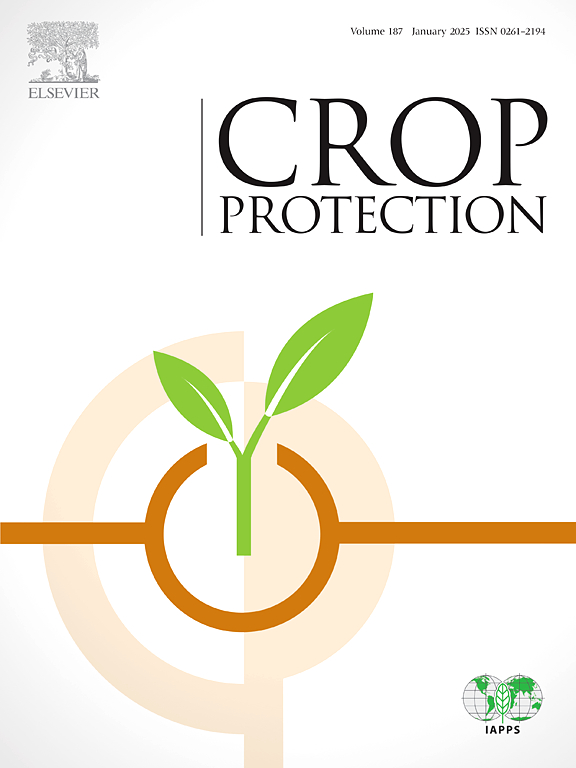Cold storage of Aphidoletes aphidimyza can extend offspring larval development period and improve its predation ability
IF 2.5
2区 农林科学
Q1 AGRONOMY
引用次数: 0
Abstract
Aphidoletes aphidimyza (Rondani) (Diptera: Cecidomyiidae) is widely used in aphid biological control, and low-temperature storage helps expand its population. Nonetheless, low-temperature effects on A. aphidimyza are unknown. A. aphidimyza pupae were exposed to three cold storage methods lasting 10, 20, and 30 days, respectively: storing at 7 °C for 4 h then 5 °C for 20 h (T1); storing at 9 °C for 4 h then 5 °C for 20 h (T2); and storing at 5 °C for 24 h (T3). The emergence rate under variable low-temperature storage (T1: 81.98%; T2: 81.28%) was significantly higher than that under constant low-temperature storage (T3: 74.98%). Additionally, the emergence rate decreased markedly with prolonged refrigeration time. Egg production at all three refrigeration temperatures declined significantly compared to the control treatment. It is noteworthy that low-temperature storage can significantly prolong the development time of offspring larvae without affecting the overall developmental period of the offspring. After comparing the content of cold-resistant substances in pupae under different low-temperature storage, the total sugar, glycerol, and trehalose increased with an extended storage time. The lifetime feeding capacity of A. aphidimyza offspring larvae on Myzus persicae (Sulzer) improved after cold storage. The functional response curve was aligned with the Holling Ⅱ model. Compared to the control treatment, both T1, T2, and T3 improved the search ability of 3rd-instar larvae in the offspring after 20 and 30 days of refrigeration. Our study indicated that cold storage of A. aphidimyza can extend offspring larval development period and improve its predation ability.
冷藏蚜虫可延长后代幼虫发育期并提高其捕食能力
蚜蝇(Aphidoletes aphidimyza (Rondani))(双翅目:蚜蝇科)被广泛用于蚜虫生物防治,低温储存有助于扩大其种群数量。然而,低温对 A. aphidimyza 的影响尚不清楚。将 A. aphidimyza 蛹分别置于三种低温条件下 10 天、20 天和 30 天:在 7 °C 下存放 4 小时,然后在 5 °C 下存放 20 小时(T1);在 9 °C 下存放 4 小时,然后在 5 °C 下存放 20 小时(T2);在 5 °C 下存放 24 小时(T3)。变低温贮藏条件下的出苗率(T1:81.98%;T2:81.28%)明显高于恒定低温贮藏条件下的出苗率(T3:74.98%)。此外,随着冷藏时间的延长,出壳率也明显下降。与对照处理相比,三种冷藏温度下的产蛋量都明显下降。值得注意的是,低温贮藏能显著延长子代幼虫的发育时间,而不影响子代的整体发育期。比较不同低温贮藏条件下蛹体内抗寒物质的含量,总糖、甘油和三卤糖的含量随着贮藏时间的延长而增加。低温贮藏后,蚜茧蜂后代幼虫对柿小蚜(Sulzer)的终生取食能力有所提高。功能反应曲线与霍林Ⅱ模型一致。与对照处理相比,T1、T2 和 T3 在冷藏 20 天和 30 天后都提高了子代三龄幼虫的搜索能力。我们的研究表明,冷藏蚜虫可延长子代幼虫的发育期,提高其捕食能力。
本文章由计算机程序翻译,如有差异,请以英文原文为准。
求助全文
约1分钟内获得全文
求助全文
来源期刊

Crop Protection
农林科学-农艺学
CiteScore
6.10
自引率
3.60%
发文量
200
审稿时长
29 days
期刊介绍:
The Editors of Crop Protection especially welcome papers describing an interdisciplinary approach showing how different control strategies can be integrated into practical pest management programs, covering high and low input agricultural systems worldwide. Crop Protection particularly emphasizes the practical aspects of control in the field and for protected crops, and includes work which may lead in the near future to more effective control. The journal does not duplicate the many existing excellent biological science journals, which deal mainly with the more fundamental aspects of plant pathology, applied zoology and weed science. Crop Protection covers all practical aspects of pest, disease and weed control, including the following topics:
-Abiotic damage-
Agronomic control methods-
Assessment of pest and disease damage-
Molecular methods for the detection and assessment of pests and diseases-
Biological control-
Biorational pesticides-
Control of animal pests of world crops-
Control of diseases of crop plants caused by microorganisms-
Control of weeds and integrated management-
Economic considerations-
Effects of plant growth regulators-
Environmental benefits of reduced pesticide use-
Environmental effects of pesticides-
Epidemiology of pests and diseases in relation to control-
GM Crops, and genetic engineering applications-
Importance and control of postharvest crop losses-
Integrated control-
Interrelationships and compatibility among different control strategies-
Invasive species as they relate to implications for crop protection-
Pesticide application methods-
Pest management-
Phytobiomes for pest and disease control-
Resistance management-
Sampling and monitoring schemes for diseases, nematodes, pests and weeds.
 求助内容:
求助内容: 应助结果提醒方式:
应助结果提醒方式:


